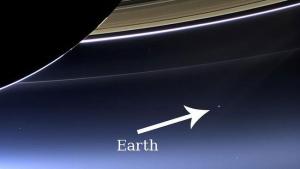The Cassini space probe has a hefty price tag, not only in material but also philosophical terms.
Adam Frank at NPR geeked out back in May in a column called “The Joy of Science,” in which he rhapsodized about the beauty and wonder contained in the data retrieved by NASA’s Saturn probes. The Cassini space probe was sending us extraordinary pictures of Saturn’s rings while the Huygens lander was finding out about conditions on Titan, the planet’s largest moon. Frank characterized this sort of high-tech inquiry in terms of childlike curiosity:
In today’s political climate, it’s hard sometimes to remember that science, at its root, is about the fun of discovery. It’s a kind of kids-play.
What animates the joy and the excitement and the inspiration so many folks feel in their encounters with science is a very pure sense of: “Wow, that is sooooooo cool.”
An old Disqus colleague of mine, Clemency, calls this kind of rhetoric the “G-whiz factor,” a skin-deep appreciation for scientific inquiry that’s more about pretty pictures than an acknowledgment of what goes along with such research. The scientific community and its cheerleaders in the media don’t just want to make Earth look small in pictures, they also want to de-emphasize the ethical, environmental and political concerns we might have about these missions.
To Infinity and Beyond (Terms and Conditions Apply)
The Cassini-Huygens mission cost $3.26 billion, according to the Jet Propulsion labs website. The main contractor for the mission was France’s Aerospatiale company, a producer of commercial and military aircraft and helicopters as well as guided missiles used by France, Britain, the USA, and Saudi Arabia. The company is now owned by telecommunications conglomerate Alcatel-Lucent , which fell afoul of both the SEC and the US Department of Justice in 2010 for its use of bribery in securing valuable contracts with foreign governments. Frank is free to characterize this kind of research as “kids-play,” but it fills the pockets of a lot of corporations involved with much less positive kinds of recreation.
Due to the impracticality of solar power for a mission so far from the Sun, the Cassini orbiter carried over 70 pounds of radioactive plutonium aboard for fuel. Considering that NASA missions have unfortunately ended in disintegration in Earth’s atmosphere, I’m interested to know what sort of risk assessment was performed concerning the effects of that much plutonium oxide being released into the atmosphere of our planet.
Let’s Get Small
Last but not least, the Cassini photographs play into an anti-human attitude common among scientists and science fans. As if no one realizes that Earth, like all objects, appears small when viewed from a long way away, scientists are quick to use this perspective to make what they consider philosophical points about human importance. In an appearance on the Late Show with Stephen Colbert, astrophysicist and science popularizer Neil deGrasse Tyson used the Cassini probe’s photo of Earth as yet another opportunity to remind us of how small and insignificant we are:
It’s odd not only that this view-from-space is considered the true perspective from which to measure human worth, but also that it doesn’t make our quest for truth and awe through scientific inquiry any less crucial. Isn’t any awe or wonder we feel about this research just a by-product of the inadequacy of our expectations about the universe too? If not, why not?
The Kicker
Frank ends his sermon with a summary of the, um, astounding and awesome things the Huygens lander has discovered about Titan:
So what did they find? Here is the all-important summary: “… the dynamics appear to be consistent with a surface consistency of damp sand.”
So there you have it. Take a minute to let it sink in and give your imagination a moment to work its own path on this.
– Damp sand.
– Damp with liquid methane.
– On a frigid but not frozen moon orbiting a giant ringed planet.
– 50 billion miles from Earth.
See, we do live in a universe of wonders. And science is the window that lets us thrill before the view.
Okay, but we seem to see through this window whatever we want to see, and it seems designed to block things from our imagination as well. Namely, any qualms we should have about the downside of this research, the risks involved, and the way it’s used to belittle us and our silly ethical concerns.
Shouldn’t we be skeptical of breathless science cheerleading like this, particularly when it distracts us from the corporate shenanigans and philosophical cynicism that brought us those pretty pictures?
















